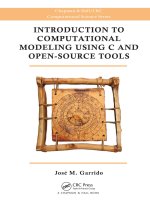- Trang chủ >>
- Khoa Học Tự Nhiên >>
- Vật lý
Fionn dunne, nik petrinic introduction to computational plasticity oxford university press (2005)
Bạn đang xem bản rút gọn của tài liệu. Xem và tải ngay bản đầy đủ của tài liệu tại đây (3.96 MB, 259 trang )
Introduction to Computational Plasticity
www.pdfgrip.com
This page intentionally left blank
www.pdfgrip.com
Introduction to
Computational Plasticity
FIONN DUNNE AND NIK PETRINIC
Department of Engineering Science
Oxford University, UK
1
www.pdfgrip.com
3
Great Clarendon Street, Oxford ox2 6dp
Oxford University Press is a department of the University of Oxford.
It furthers the University’s objective of excellence in research, scholarship,
and education by publishing worldwide in
Oxford New York
Auckland Cape Town Dar es Salaam Hong Kong Karachi
Kuala Lumpur Madrid Melbourne Mexico City Nairobi
New Delhi Shanghai Taipei Toronto
With offices in
Argentina Austria Brazil Chile Czech Republic France Greece
Guatemala Hungary Italy Japan Poland Portugal Singapore
South Korea Switzerland Thailand Turkey Ukraine Vietnam
Oxford is a registered trade mark of Oxford University Press
in the UK and in certain other countries
Published in the United States
by Oxford University Press Inc., New York
© Oxford University Press, 2005
The moral rights of the authors have been asserted
Database right Oxford University Press (maker)
First published 2005
Reprinted 2006 (with corrections)
All rights reserved. No part of this publication may be reproduced,
stored in a retrieval system, or transmitted, in any form or by any means,
without the prior permission in writing of Oxford University Press,
or as expressly permitted by law, or under terms agreed with the appropriate
reprographics rights organization. Enquiries concerning reproduction
outside the scope of the above should be sent to the Rights Department,
Oxford University Press, at the address above
You must not circulate this book in any other binding or cover
and you must impose the same condition on any acquirer
British Library Cataloguing in Publication Data
(Data available)
Library of Congress Cataloging in Publication Data
(Data available)
Typeset by Newgen Imaging Systems (P) Ltd., Chennai, India
Printed in Great Britain
on acid-free paper by
Biddles Ltd, King’s Lynn
ISBN 0-19-856826-6 (Hbk)
978-0-19-856826-1
3 5 7 9 10 8 6 4 2
www.pdfgrip.com
To Hannah and Roberta, with love
www.pdfgrip.com
This page intentionally left blank
www.pdfgrip.com
Preface
The intention of this book is to bridge the gap between undergraduate texts in
engineering plasticity and the many excellent books in computational plasticity aimed
at more senior graduate students, researchers, and practising engineers working in
solid mechanics. The book is in two parts. The first introduces microplasticity and
covers continuum plasticity, the kinematics of large deformations and continuum
mechanics, the finite element method, implicit and explicit integration of plasticity
constitutive equations, and the implementation of the constitutive equations, and the
associated material Jacobian, into finite element software. In particular, the implementation into the commercial code ABAQUS is addressed (and to help, we provide a range
of ABAQUS material model UMATs), together, importantly, with the tests necessary
to verify the implementation. Our intention, wherever possible, is to develop a good
physical feel for the plasticity models and equations described by considering, at
every stage, the simplification of the equations to uniaxial conditions. In addition, we
hope to provide a reasonably physical understanding of some of the large deformation
quantities (such as the continuum spin) and concepts (such as objectivity) which are
often unfamiliar to many undergraduate engineering students who demand more than
just a mathematical description.
The second part of the book introduces a range of plasticity models including those
for superplasticity, porous plasticity, creep, cyclic plasticity, and thermo-mechanical
fatigue (TMF). We also describe a number of practical applications of the plasticity
models introduced to demonstrate the reasonable maturity of continuum plasticity in
engineering practice.
We hope, above all, that this book will help all those—undergraduates, graduates,
researchers, and practising engineers—who need to move on from knowledge of
undergraduate plasticity to modern practice in computational plasticity. Our aims
have been to encourage development of understanding, and ease of passage to the
more advanced texts on computational plasticity.
September 2004
F. P. E. D. and N. P.
www.pdfgrip.com
This page intentionally left blank
www.pdfgrip.com
Contents
Acknowledgements
xii
Notation
xiii
Part I. Microplasticity and continuum plasticity
1.
1.1
1.2
1.3
1.4
2.
2.1
2.2
2.3
2.4
2.5
2.6
2.7
3.
3.1
3.2
3.3
3.4
3.5
Microplasticity
3
Introduction
Crystal slip
Critical resolved shear stress
Dislocations
Further reading
Continuum plasticity
3
5
7
8
10
11
Introduction
Some preliminaries
Yield criterion
Isotropic hardening
Kinematic hardening
Combined isotropic and kinematic hardening
Viscoplasticity and creep
Further reading
Kinematics of large deformations and continuum mechanics
Introduction
The deformation gradient
Measures of strain
Interpretation of strain measures
Polar decomposition
www.pdfgrip.com
11
11
17
23
27
36
38
45
47
47
48
49
52
57
x
Contents
3.6
3.7
3.8
3.9
Velocity gradient, rate of deformation, and continuum spin
Elastic–plastic coupling
Objective stress rates
Summary
Further reading
60
66
69
81
82
4.
The finite element method for static and dynamic plasticity
83
Introduction
Hamilton’s principle
Introduction to the finite element method
Finite element equilibrium equations
Integration of momentum balance and equilibrium equations
Further reading
83
84
96
100
136
142
4.1
4.2
4.3
4.4
4.5
5.
5.1
5.2
5.3
5.4
5.5
5.6
6.
6.1
6.2
6.3
6.4
6.5
6.6
Implicit and explicit integration of von Mises plasticity
Introduction
Implicit and explicit integration of constitutive equations
Material Jacobian
Kinematic hardening
Implicit integration in viscoplasticity
Incrementally objective integration for large deformations
Further reading
Implementation of plasticity models into finite element code
Introduction
Elasticity implementation
Verification of implementations
Isotropic hardening plasticity implementation
Large deformation implementations
Elasto-viscoplasticity implementation
143
143
143
150
154
161
167
168
169
169
170
171
172
176
180
Part II. Plasticity models
7.
7.1
7.2
Superplasticity
185
Introduction
Some properties of superplastic alloys
www.pdfgrip.com
185
185
Contents
7.3
7.4
8.
Constitutive equations for superplasticity
Multiaxial constitutive equations and applications
References
Porous plasticity
8.1
8.2
9.
Creep in an aero-engine combustor material
9.1
9.2
9.3
189
192
197
199
Introduction
Finite element implementation of the porous material
constitutive equations
Application to consolidation of Ti–MMCs
References
8.3
xi
Introduction
Physically based constitutive equations
Multiaxial implementation into ABAQUS
References
Appendix 9.1
199
201
205
207
209
209
209
212
217
218
10. Cyclic plasticity, creep, and TMF
219
10.1 Introduction
10.2 Constitutive equations for cyclic plasticity
10.3 Constitutive equations for C263 undergoing TMF
References
219
219
222
227
Appendix A: Elements of tensor algebra
229
Differentiation
The chain rule
Rotation
231
232
233
Appendix B: Fortran coding available via the OUP website
235
Index
239
www.pdfgrip.com
Acknowledgements
The authors would like to express their sincere gratitude to Esteban Busso for reading
a draft and providing many helpful comments and suggestions, to Paul Buckley for
the provision of the figures in Chapter 1, and to Jinguo Lin for permission to use
Figures 7.9–7.14.
The authors acknowledge, with gratitude, permission granted to reproduce the
following figures:
Figures 7.9–7.14: Elsevier Ltd, Oxford, UK.
Figures 8.1–8.6: Institute of Materials Communications Ltd, London, UK.
Figures 9.1–9.4, 10.1–10.3: Elsevier Ltd, Oxford, UK.
www.pdfgrip.com
Notation
• Regular italic typeface (v, σ, . . .): scalars, scalar functions.
• Bold italic typeface (P , v, A, σ , . . .): points, vectors, tensors, vector and tensor
functions.
• Helvetica bold italic typeface (C, c, I, . . .): fourth order tensors.
Operations
f (·)
det[·]
Tr[·]
ln(·)
[·]
∂
[·]
∂x
∇(·) = grad[·]
div[·] = tr[∇(·)]
x·y
x⊗y
σ :ε
√
|u| = √u · u
|A| = A : A
function of (·)
determinant of [·]
trace of [·]
logarithm of (·)
increment of [·]
partial derivative of [·] with respect to x
gradient of [·]
divergence of [·]
scalar product of vectors
dyadic product of vectors
double contraction of tensors
norm of vector
norm of tensor
Some commonly used notation
C
D
E
E
ε
fourth-order tensor of material constants
rate of deformation tensor
Lagrangian strain tensor
Young’s modulus
strain tensor
www.pdfgrip.com
xiv
F
f
I
J
K
M
P
P
R
R
t
t
u
u
uă
W
Notation
deformation gradient
force vector eld
density
second-order identity tensor
Jacobian
stiffness matrix
mass matrix
Poissons ratio
material particle
material point ∈ Rn
rotation tensor
real set
Cauchy stress tensor
time
surface traction vector
displacement vector field
velocity vector field
acceleration vector field
work
www.pdfgrip.com
Part I. Microplasticity and
continuum plasticity
www.pdfgrip.com
This page intentionally left blank
www.pdfgrip.com
1. Microplasticity
1.1
Introduction
This chapter briefly introduces the origins of yield and plastic flow, and in particular,
attempts to explain the usual assumptions in simple continuum plasticity of isotropy,
incompressibility, and independence of hydrostatic stress. While short, we introduce
grains, crystal slip, slip systems, resolved shear stress, and dislocations; the minimum
knowledge of microplasticity for users of continuum plasticity.
The origin of plasticity in crystalline materials is crystal slip. Metals are usually
polycrystalline; that is, made up of many crystals in which atoms are stacked in
a regular array. A typical micrograph for a polycrystalline nickel-base superalloy is
shown in Fig. 1.1 in which the ‘crystal’ or grain boundaries can be seen. The grain size
is about 100 µm. The grain boundaries demarcate regions of different crystallographic
orientation.
If we represent the crystallographic structure of a tiny region of a single grain by
planes of atoms, as shown in Fig. 1.2(a), we can then visualize plastic deformation
taking place as shown in Fig. 1.2(a) and (b); this is crystallographic slip. Unlike
elastic deformation, involving only the stretching of interatomic bonds, slip requires
the breaking and re-forming of interatomic bonds and the motion of one plane of
atoms relative to another. After shearing the crystal from configuration 1.2(a) to
configuration 1.2(b), the structure is unchanged except at the extremities of the crystal.
A number of very important phenomena in macroscopic plasticity become apparent
from just two Figs 1.1 and 1.2:
(1) plastic slip does not lead to volume change; this is the incompressibility condition
of plasticity;
(2) plastic slip is a shearing process; hydrostatic stress, at the macrolevel, can often
be assumed not to influence slip;
(3) in a polycrystal, plastic yielding is often an isotropic process.
As we will see later, the incompressibility condition is very important in macroscale plasticity and manifests itself at the heart of constitutive equations for plasticity.
www.pdfgrip.com
4
Microplasticity
100 mm
Fig. 1.1 Micrograph of polycrystal nickel-base alloy C263.
(a)
τ
(b)
τ
τ
τ
Fig. 1.2 Schematic representation of the crystallographic structure within a single grain undergoing
slip.
However, not all plastic deformation processes are incompressible. A porous metal,
for example, under compressive load may undergo plastic deformation during which
the pores reduce in size. Consequently, there is a change of volume and a dependence
on hydrostatic stress. However, the volume change does not originate from the plastic
slip process itself, but from the pore closure.
The fact that plastic slip is a shearing process gives more information about the
nature of yielding; in principle, it tells us that plastic deformation is independent of
hydrostatic stress (pressure). For non-porous metals, this is one of the cornerstones
of yield criteria. The von Mises criterion, for example, is one in which the initiation
of macroscale yield is quite independent of hydrostatic stress. If we take a sample of
the theoretical material shown schematically in Fig. 1.2(a) and submerge it to an ever
deeper depth in an imaginary sea of water, the hydrostatic stress becomes ever larger
but causes no more than the atoms in the theoretical material to come closer together.
It will never in itself be able to generate the shearing necessary for crystallographic slip.
Figure 1.1 shows a micrograph of a polycrystal. If we assume that there is no preferred crystallographic orientation, but that the orientation changes randomly from one
www.pdfgrip.com
Crystal slip
(a)
5
(b)
Fig. 1.3 (a) Photograph of a single zinc crystal and (b) a schematic diagram representing single slip
in a single crystal.
grain to the next, and if our sample of material contains a sufficiently large number of grains, we can get a reasonable physical feel that macroscale yielding of
the material will be isotropic. This is a further cornerstone of the von Mises yield
criterion.
1.2
Crystal slip
The evidence for crystal slip being the origin of plasticity comes from mechanical
tests carried out on single crystals of metals.
The single crystal of zinc shown in Fig. 1.3(a) is a few millimetres in width and has
been loaded beyond yield in tension. The planes that can be seen are those on which
slip has occurred resulting from many hundreds of dislocations running through the
crystal and emerging at the edge. Each dislocation contributes just one Burger’s vector
of relative displacement, but with many such dislocations, the displacements become
large. Figure 1.3(b) shows schematically what is happening in Fig. 1.3(a). The ends of
the test sample have not been constrained in the lateral directions. It can be seen that
single slip in this case leads to the horizontal displacement of one end relative to
the other. Had this test been carried out in a conventional uniaxial testing machine,
the lateral motion would have been prevented. In order to retain compatibility, then,
with the imposed axial displacement, the slip planes would have to rotate towards the
loading direction. The uniaxial loading therefore leads not only to crystallographic
slip, but also to rotation of the crystallographic lattice.
1.2.1
Slip systems: slip directions and slip normals
Observations on single crystals show that slip tends to occur preferentially on certain
crystal planes and in certain specific crystal directions. The combination of a slip
www.pdfgrip.com
6
Microplasticity
(111)
–
[110]
¯ in an fcc lattice.
Fig. 1.4 The particular slip system (111)[110]
(112)
(101)
(123)
–
(111)
Fig. 1.5 Slip systems in bcc materials.
plane and a slip direction is called a slip system. These tend to be the most densely
packed planes and the directions in which the atoms are packed closest together.
This is explained in terms of dislocations. In face centred cubic (fcc) materials,
the most densely packed planes are the diagonal planes of the unit cell. In fact the
crystal is ‘close-packed’ in these planes; the observed slip systems are shown in
Fig. 1.4.
¯ {111}.
The full family of slip systems in such crystals may be written as 110
There are 12 such systems in an fcc crystal (four planes each with three directions).
In body centre cubic (bcc) crystals, there are several planes that are of similar
density of packing, and hence there are several families of planes on which slip occurs.
However, there is no ambiguity about the slip direction, since the atoms are closest
¯ direction and those equivalent to it. The slip systems observed in bcc
along the [111]
crystals are shown in Fig. 1.5.
Thus, there are three families of slip systems operative:
111¯ {101};
111¯ {112};
111¯ {123}.
Table 1.1 shows the slip systems found in single crystals of some of the important fcc
and bcc pure metals together with the resolved shear stress required to cause slip—the
critical resolved shear stress (CRSS).
www.pdfgrip.com
Critical resolved shear stress
7
Table 1.1 Slip systems and CRSS for some pure metals.
Metal
Structure
Slip systems
CRSS (MPa)
Cu
Al
Ni
fcc
fcc
fcc
0.64
0.40
5.8
α-Fe
Mo
Ta
bcc
bcc
bcc
¯ {111}
110
¯ {111}
110
¯ {111}
110
¯
111 {101}, 111¯ {112}, 111¯ {123}
111¯ {101}
111¯ {101}, 111¯ {112}, 111¯ {123}
32
50
50
t
Slip plane normal
n
s
f
l
s Slip direction
Fig. 1.6 A single crystal containing slip plane with normal n, slip direction s, and loaded in
direction t.
1.3
Critical resolved shear stress
Suppose a single crystal in the shape of a rod is tested in tension. The axis of the rod
is parallel to unit vector t. The crystal has an active slip plane, normal in direction
of unit vector n. It has an active slip direction parallel to unit vector s, as shown in
Fig. 1.6.
When the applied tensile stress is σ , the shear stress acting on the slip plane and in
the slip direction is τ which may be found as follows: if the cross-sectional area of
the rod is A, the force in the slip direction is Aσ cos λ and it acts on an area A/cos φ
of the slip plane. Hence the resolved shear stress is
τ = σ cos φ cos λ = σ (t · n)(t · s).
(1.1)
Slip will take place on the slip system, that is, the crystal will yield, when τ reaches the
CRSS. This is known as Schmid’s law. The data shown in Fig. 1.7 were obtained from
tensile tests on cadmium single crystals which are hexagonal close packed (hcp). The
measured yield stress depends upon the angle between the tensile loading direction
and the basal plane. The minimum stress to cause yield occurs when the tensile axis is
45◦ to this plane, that is, when the shear stress is maximized. Schmid’s law provides
a good explanation for the observed behaviour.
www.pdfgrip.com
8
Microplasticity
7
Data
Schmid’s law
Yield stress (MPa)
6
5
4
3
2
1
0
0
30
60
90
Angle between tensile axis and basal plane
Fig. 1.7 The dependence of yield stress on the angle between the tensile axis and basal plane in an hcp
cadmium single crystal.
b
Fig. 1.8 An edge dislocation.
1.4
Dislocations
The theoretical shear strength of a crystal, calculated assuming that the shear is
homogeneous (the entire crystal shears simultaneously on one plane), is given by
G
.
τth =
2π
The expected shear strength is therefore very large; many orders of magnitude greater
than the CRSS values are shown in Table 1.1. The assumption of homogeneous shear is,
of course, wrong and plastic deformation in crystals normally occurs by the movement
of the line defects known as dislocations, that are usually present in large numbers.
The glide of a dislocation involves only very local rearrangements of atoms close to it,
and requires a stress much lower than τth , thereby explaining the low observed values
of CRSS.
Each dislocation is associated with a unit of slip displacement given by the Burgers
vector b. Since the dislocation is a line defect, there are two extreme cases. Figure 1.8
shows a schematic representation of an edge dislocation.
In this case the Burgers vector b is perpendicular to the line of the dislocation,
and the dislocation corresponds to the edge of a missing half-plane of atoms. Thus b and
www.pdfgrip.com
Dislocations
9
b
Fig. 1.9 A screw dislocation.
the dislocation line define a plane: a specific slip plane. If l is a unit vector parallel to
the dislocation line, then
s=
b
|b|
and
n=
b×l
.
|b|
(1.2)
Figure 1.9 shows a schematic representation of a screw dislocation. This is the
other extreme case where the Burger’s vector is parallel to the dislocation line. The
dislocation itself corresponds to a line of scissors-like shearing of the crystal. It follows
from the fact that b is parallel to l, that, although the slip direction s is defined, the slip
plane n is not. Hence, a screw dislocation can cause slip on any slip plane containing l.
Dislocations are therefore vital in understanding yield and plastic flow.
We have said nothing about the important role of dislocations in strain hardening and
softening. Nor have we discussed the effect of temperature on diffusivity which influences or controls many plastic deformation mechanisms including thermally activated
dislocation climb leading to recovery, vacancy core and boundary diffusion, and grain
boundary sliding. All of these subjects can be found in existing materials text books,
some of which are listed below. Our aim has been to include sufficient material on
microplasticity to ensure that the physical bases of at least some of the assumptions
made in macrolevel continuum plasticity are understood.
There have been many developments over the last 25 years in physically based
microplasticity modelling, including the development of time-independent and ratedependent crystal plasticity. Here, for a given crystallographic lattice (e.g. fcc),
using finite element techniques, the resolved shear stresses on all slip systems can
be determined to find the active slip systems. Within either a time-independent or
rate-dependent formulation, the slip on each active system can be determined from
which the overall total deformation can be found. Such models are being used successfully for the plastic and creep deformation of single crystal materials which find
application in aero-engines. The modelling of single crystal components has become
www.pdfgrip.com
10
Microplasticity
possible with the development of high-performance computing. More recently, using
finite element techniques, polycrystal plasticity models have been developed. Here,
the understanding of microplasticity discussed above is also employed and again, as
in single crystal plasticity, the active slip systems can be identified and the corresponding slips determined to give the overall deformation within a given grain. This
is now done for all the grains in the polycrystal, which all have their own measured
or specified crystallographic orientations, subject to the requirements of equilibrium
and compatibility which are imposed within the finite element method. In order to do
this, it is necessary to generate many finite elements within each grain. It is clear that
for large numbers of grains, such polycrystal plasticity modelling becomes untenable. The consequence is that while desirable, it is not (for the foreseeable future)
going to be feasible to carry out polycrystal plasticity modelling at the engineering
component level. Currently, and for many years to come, the plastic deformation occurring in both the processing to produce engineering components, and occurring under
in-service conditions at localized regions of a component, will continue to be modelled using continuum-level plasticity. This is particularly so in engineering industry
where pressures of time and cost demand rapid analyses. We will now, therefore, leave
microplasticity and address, in the remainder of the book, continuum-level plasticity.
Further reading
Dieter, G.E. (1988). Mechanical Metallurgy. McGraw-Hill Book Co., London.
Meyers, M.A., Armstrong, R.W., and Kirchner, H.O.K. (1999). Mechanics and
Materials. Fundamentals and Linkages. John Wiley & Sons Inc., New York.
www.pdfgrip.com









